Is It Worth Repairing Pc Power Supply
In this article, we will examine the blueprint of a simple ATX power supply, and show you what components are usually missing in cheap Chinese power supplies due to the manufacturer's desire to get in even cheaper. Nosotros will say a few words near their reliability and the near widespread causes for their breakdown. We will also demonstrate how to diagnose their possible defects and measure voltage nether load and without it.

For analogy, we'll be using this ability supply model, Oktet ATX-400W.
- Capacity: 400 W
- ATX form cistron
- Efficiency rating: seventy%
- Cooling: lxxx mm fan
- Power Factor Correction module: active
- Voltage stabilization: none
- Overload protection: none
- Brusque circuit protection: yes
Contents:
- The main cause of harm and correct capacity calculation for ATX power supplies
- How to cheque the output voltage
- Pattern of simple ATX power supplies
- Eliminating defects and improving the ability supply
- Later on all the improvements, the device should be tested
- How to connect an incandescent lite seedling for testing the PSU under load

The chief cause of damage and correct capacity adding for ATX power supplies
Because of mistakes in capacity adding this PSU survived a brusque circuit nether load. Insulation on the outer load wires has melted and some wires burnt completely.
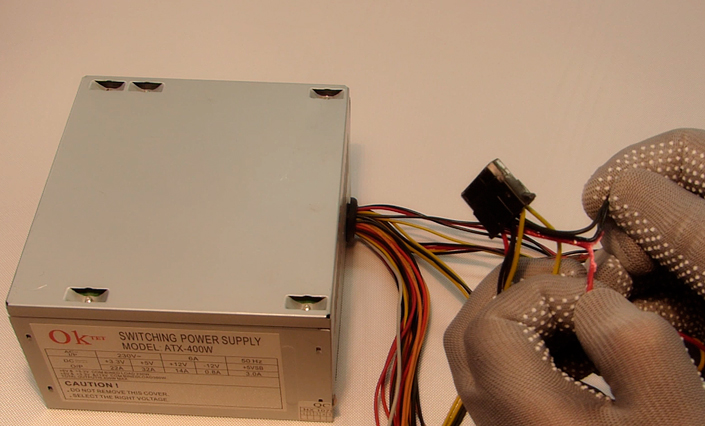
Why did it happen?
The advertised capacity of the power supply unit is 400 W, but the real output of such dirt-cheap PSU is nearly 250 West at all-time.
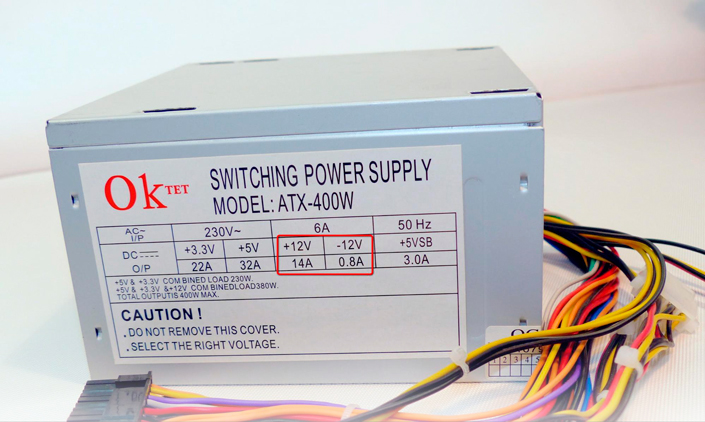
Modern computers draw most of the power they swallow in the 12-volt rail. This is the rail that powers almost everything in your machine. If you look at the 12-volt / 15-amp rail of this PSU and convert information technology into watts, you lot volition get its true chapters of 180 W (12V*15А = 180 W).
Here's the conclusion: be very attentive when you look at the stickers on the PSU y'all're about to purchase, and focus on the 12-volt runway effigy.
Hither's an example of a good quality 400 W PSU with right ability specifications. In this case, you lot tin meet easily how much real power yous get in the 12-volt rail – the true 275 West.
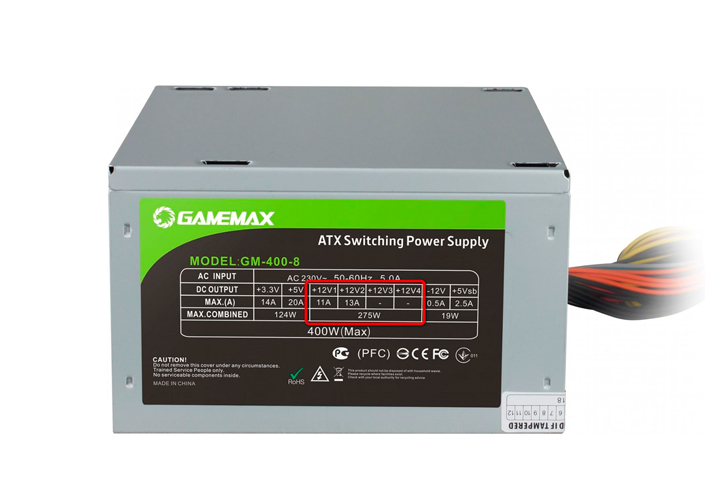
However, this power supply provides correct voltage in all rails (12-volt, 5-volt, three.3-volt), then the bottom line is as follows: such PSUs are quite durable but not too reliable, every bit they don't offering either voltage stabilization or overload protection. Often, some components are missing from such ability supplies, and they can break down, knocking out your motherboard or processor as well.
How to cheque the output voltage
You lot can use ready-made solutions from Mainland china – such as this digital tester – to notice out how much power the PSU actually gives yous.
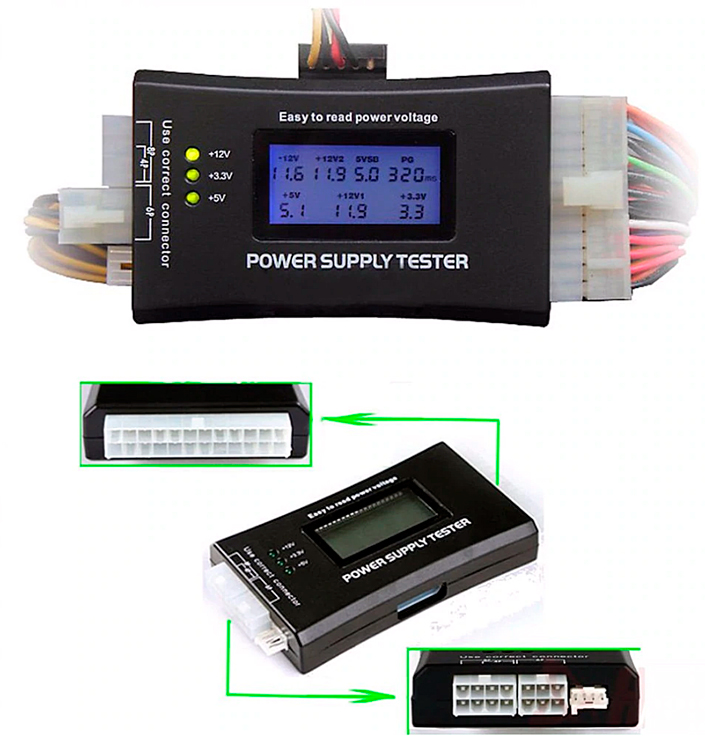
Too, an ordinary voltmeter will exercise. First of all, you lot'll take to plough the ability supply on, and it requires locating the standby contact first. You can see it in the main connector that delivers power to the motherboard: this is the green wire.
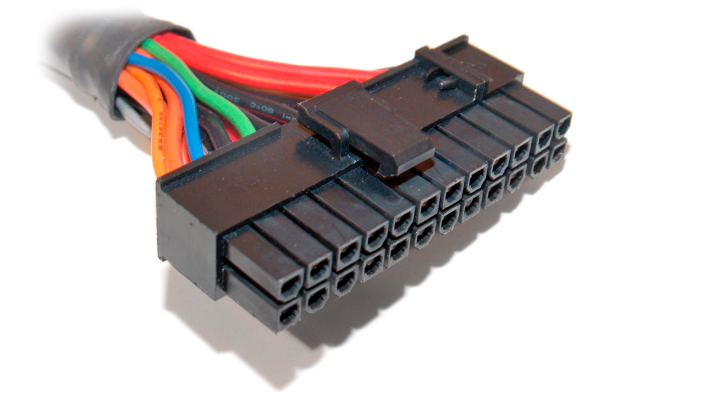
To outset the PSU, connect this contact with the black wire (ground). Y'all can exercise it with a paper clip or tweezers. Voltage on outer ability connectors will just announced after the power supply turns on – you can detect it past rotating cooling fan.

After the PSU starts, check the voltage readings for all runway.
If all figures are normal, connect an equivalent of load.
In this role, you tin can use a 12-volt light bulb with the capacity of around 100 W.
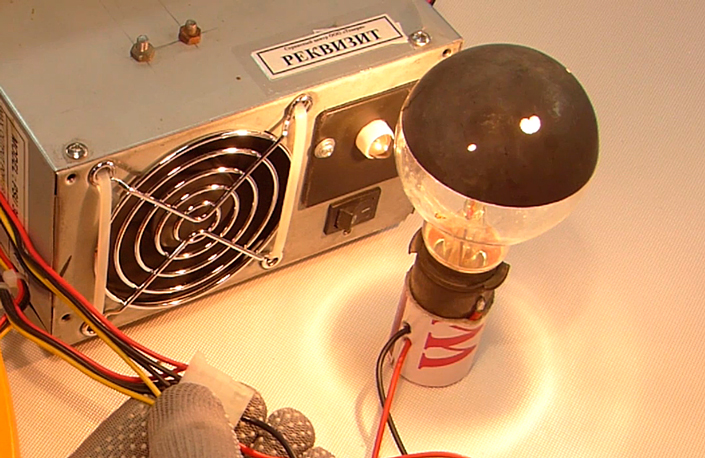
Yet there is a better plan: take the ability supply apart and examine its components visually before connecting an equivalent of load. We demand to make sure the chokes are not burnt, and the loftier-voltage capacitors are not bulging.
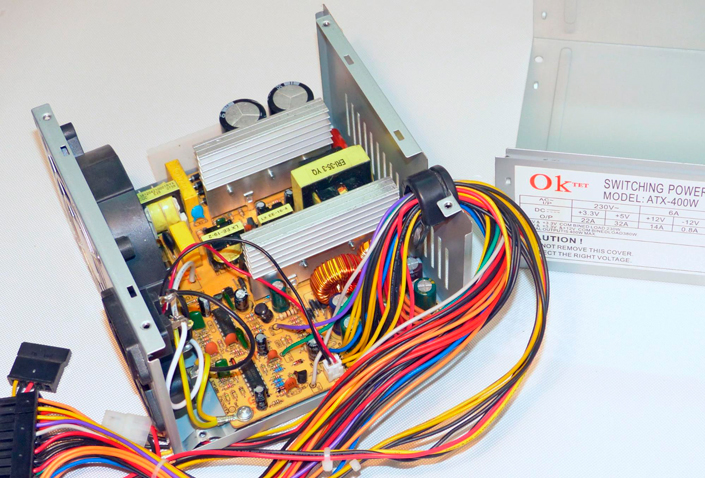
Take out the 4 screws, remove the top cover, pick the circuit lath carefully and examine it. Visually, in that location is no damage to the inside, the capacitors are intact, and the circuit lath is clean.
Design of elementary ATX power supplies
This ability supply follows a typical design for ATX units. The input voltage of 220V comes from the ability connector to the circuit board – which is missing an input surge protector, but there is an empty place for soldering it, which suggests another attempt of the Chinese manufacturer to save on the seemingly "unnecessary" components.
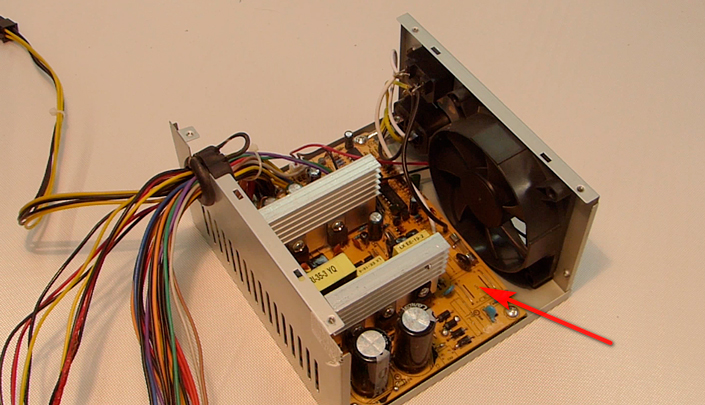
Afterwards that, voltage travels to the diode (rectifier) bridge, and nosotros can see two storage capacitors, 470 microfarads each, which is the minimal capacity for the advertised ability output.
On the commencement heatsink, there are two semiconductor ability keys and the transistor of the multiple-output standby voltage generator. Backside it, there is an isolating transformer and a standby transformer.
On the other heatsink, you can run across the low-voltage part of the PSU, Schottky diodes, followed past the asphyxiate coil for +five-volt and +12-volt rail, and a asphyxiate for the three.3-volt track, the ability cables for external connectors and the power line for the cooling fan.
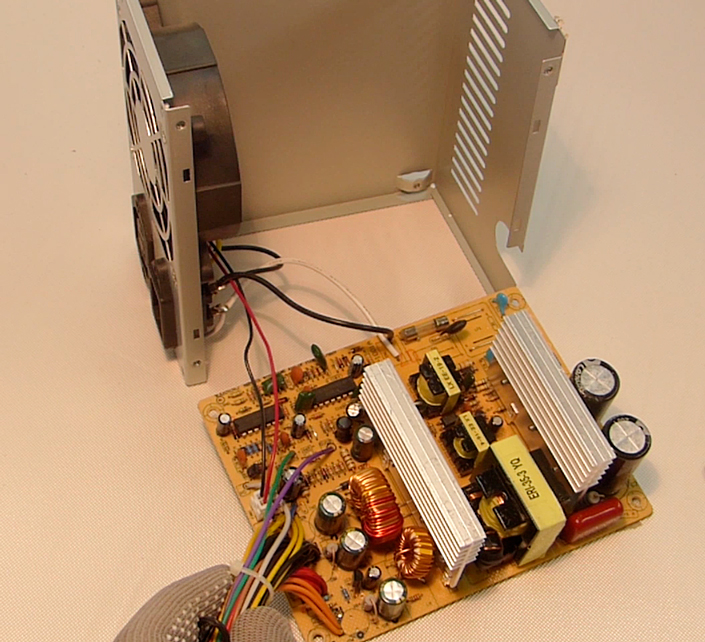
Eliminating defects and improving the power supply
We checked the diodes in the rectifier bridge for breakdown, simply they work properly. Now, the beginning thing to be replaced is the wires used to deliver power to other components of the computer. The ability cablevision for the motherboard is not damaged.
At present we've replaced the wires and added some upgrades to this PSU. In the output office, we added 3 1,500 microfarads capacitors as the stock 1,000 microfarads capacitors were bereft for the advertised capacity of the PSU. Nosotros as well added a asphyxiate and filtering capacitors for the input voltage of the 220V main. In the loftier-voltage role, nosotros also had to replace the stock capacitors with loftier-quality ones, 560 microfarads each, because testing of the capacitors soldered to the circuit lath revealed there were merely 2 Chinese capacitors with the actual capacity of 250 microfarads each – instead of the two capacitors 470 microfarads each as recommended for such configurations.
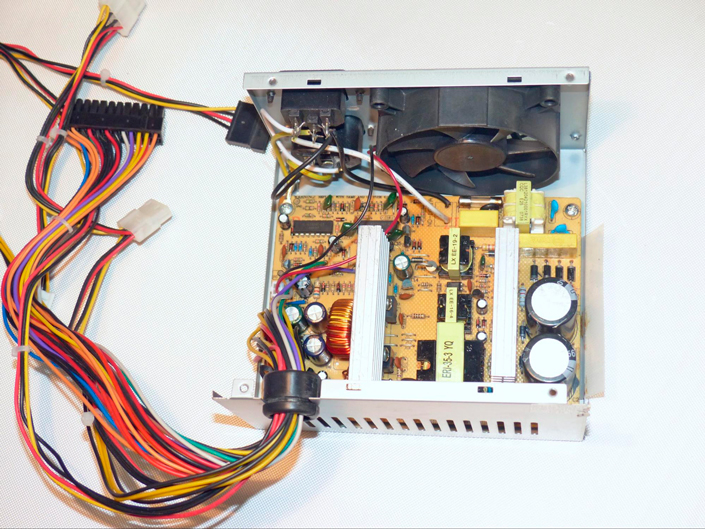
Later all the improvements, the device should be tested.
Connect input voltage of 220V, check the standby voltage on the motherboard power connector, connect this contact with the ground cable and start the power supply. The power supply starts, and the cooling fan is rotating.
Let's check the voltage for every rail – v-volt, 12-volt and three.3-volt.
- +5-volt rail – 5V
- +12-volt rails – 11.97V
- 3.3-volt rail – 3.38V
How to connect an incandescent light bulb for testing the PSU nether load
There is 1 thing we'd like to depict your attention to when using a powerful incandescent light bulb as an equivalent of load.
The incandescent light bulb is a non-linear element, and its resistance changes as the filament becomes warmer. When it's cold, information technology has a very low resistance – 0.3 Ohm, for case. That's why when yous connect it to a 12-volt rail equally an equivalent of load, the overcurrent protection element responds.
Merely if you lot warm the filament within the seedling with lower voltage, for instance, 5V, and then connect it to a 12-volt rails, the PSU protection will not reply, Equally the filament has been heated and its resistance has increased. Now let'southward try measuring the filament resistance right later on you cutting off the ability supply – information technology says over four Ohm! As the lite bulb cools downwards, its resistance gest lower, and you lot will see nigh 0.ii Ohm at room temperature.
With the cold seedling having resistance of 0.ii Ohm, the current impulse will be virtually 60 amps (Ohm'due south police force – I=V/Ohm), which exceeds the permissible current for a 12-volt rail of an ATX switching power supply. With the bulb which has been warmed up, the 12-volt runway electric current volition only be betwixt 2A and 5A.
Now let'southward attempt connecting additional load – in the form of this lite bulb, and the PSU protection is not supposed to react. At first, connect the bulb to the five-volt rail – information technology only glows but non shines. Now permit's change it to the 12-volt rail – the calorie-free becomes brighter.
The next phase is to have voltage readings from every rail when under load.
- 12-volt rail dips down to 11.72V
- 5-volt rail – to 4.98V
- 3-volt runway – to three.31V
All readings fall within the permitted limits.
If the power supply works steadily, it'southward fourth dimension to put it together.
Don't forget to put a protective clip on the cables to avoid breakdown to chassis which may occur when their insulation is damaged.
After that, the power supply should exist tested once more, with load applied to the 12-volt rail. Now that it works properly, you can fifty-fifty use it to build a low-cease PC.
At present that the experiment is over, permit'southward hope your repairs are always successful, and all your devices work as they should for a very long time.
Similar Data Recovery Tips Picked Simply for You:
Engagement:
Is It Worth Repairing Pc Power Supply,
Source: https://www.starusrecovery.com/articles/repair-computer-atx-power-supply.html
Posted by: reynoldsrefort.blogspot.com


0 Response to "Is It Worth Repairing Pc Power Supply"
Post a Comment